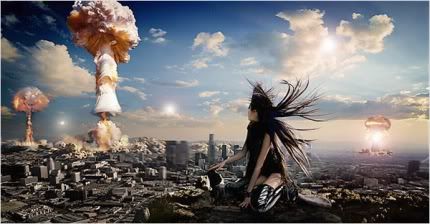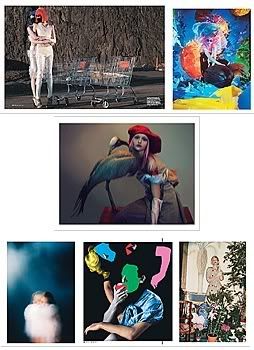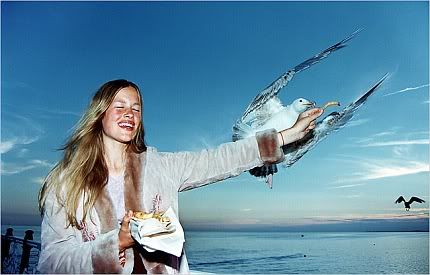Arte y Fotografía de Modas.
Fashion & Style |
| Work With Me, Baby By GUY TREBAY Published: December 6, 2007 |
 Seb Janiak/In Fashion '07 Miami Beach Art Photo Expo A photograph by Seb Janiak that is part of In Fashion '07 Miami Beach Art Photo Expo. |
| FASHION is a stepchild, in photography no less than in other areas of the culture. The reach of the imagery it produces influences everything from trash television to presidential campaigns. Yet the slick work cranked out by the fashion machine is rarely taken seriously. Museums relegate fashion picture shows to their basements. Art galleries disdain fashion photographs as work for hire. Auction houses have historically tended to accord fashion images second-class status, sneaking a few first-rate fashion pictures into sales of photography's certified masters. It's not hard to fathom why friction exists between practitioners of fine art and fashion photography. For every self-styled Cindy Sherman hoping to hit it big in the gallery world, there are scores of competent but doubtless overpaid journeymen (fees of $100,000 a day are not rare for top fashion photographers) toiling in advertising's lucrative fields. "For a long time in the quote unquote fine arts world, fashion was a dirty word," said Joshua Holdeman, international director of the photography department at Christie's. "We're far enough away from the work now," he added, referring to the early examples from the canon, "to realize it is a valuable cultural product that belongs in the pantheon of art history." |
 W Magazine From a strip of fashion photographs from W magazine |
Signs of this seem to be everywhere. Last January, a show of pictures by five important contemporary fashion photographers was mounted at the National Portrait Gallery in London. Designating 2009 as the Year of Fashion, the International Center of Photography in New York recently announced an ambitious roster of shows celebrating the fashion image, beginning with a survey of contemporary work, moving through a retrospective of fashion images by Edward Steichen and Richard Avedon, and closing with the third I.C.P. Triennial, whose theme will be the cultural ubiquitousness of fashion imagery. And this week, fashion photography makes its debut at Art Basel Miami Beach, the annual trade fair that is to the art world what the Coachella festival in Southern California is to indie rock. In Fashion '07, an assembly of 20 contemporary photographers brought together by Marion de Beaupre, a curator and author, opened Dec. 2 at the Surfcomber Hotel. Part survey and part marketing trial balloon, the show also tests the premise that the traditional borders between fine and commercial art are now permeable. "As the market becomes so broad and there are so many people who have the means to collect," fashion pictures have been upgraded both critically and in the marketplace, Mr. Holdeman said. "The imagery is easy to approach and accessible in price," he added, although accessible in this case may be a relative term. Prices for images by photographers like Serge Lutens, Max Vadukul and Willy Vanderperre are modest by Art Basel Miami Beach standards (generally under $10,000). But the Irving Penn platinum print a farseeing collector might have picked up at auction 10 years ago for under $8,000 would now command $350,000, Mr. Holdeman said. |
 Max Vadukul In Fashion '07 Miami Beach Art Photo Expo |
| A paradoxical dimension of the current lively interest in the field is that the innovative spirit and visual daring of the late '90s when many photographers were mining their personal lives as well as the weirder byways of pop culture, including pornography, and were also eschewing technological wizardry in favor of raw emotional response appears to have gone into retreat. Some in the industry point to the economy and the conservative tenor of most mainstream fashion magazines to explain this development. Some claim that a backlash against images condemned (by Bill Clinton, among others) for glorifying "heroin chic" in the mid-90s resulted in self-chastening throughout the industry. Many note that the marquee names of the moment were already the establishment a decade ago. Where is the generation that ought by now to have supplanted stars like Jean-Baptiste Mondino, Ellen von Unwerth, Mario Testino or Nick McKnight? Who knows? "It's obviously a complicated issue," said Dennis Freedman, the creative director of W magazine, perhaps the most visually daring of mainstream American fashion publications. "There are many photographers working today who have a lot to say, who have points of view, who have a voice that's intelligent and considered," he added. "Unfortunately within the fashion world there aren't enough opportunities to create that meaningful work." True, there was a period within the last decade, said Vince Aletti, a photography critic for The New Yorker and adjunct curator at the International Center of Photography, "when every time I went to look at a fashion magazine, I was psyched." At the moment, he added, "there is not much to jump out of your seat about." There is little around quite as startling as the "Fight Club" pictorial that Steven Klein photographed for W, in which Brad Pitt posed covered with sweat and grime and so little else that the magazine's caption writers were taxed. There is little that seems so controversial as Mr. Klein's pictures of Justin Timberlake, which appeared just after 9/11, images whose borders were singed and whose pretty boy subject was shown with his nose caked in blood. Even Mr. Klein's pictures of a compulsive exhibitionist like Madonna, posed atop a table with her foot behind her head and her crotch thrust toward the viewer, seems to belong to another, more provocative time. "The entirety of that Madonna sitting was very dark," Mr. Aletti said. "And it couldn't have been further from the classicism and clean lines of Beaton and Horst." |
 Elaine Constantine/In Fashion '07 Miami Beach Art Photo Expo A photograph by Elaine Constantine that is part of the Miami Beach show. |
| Like the 20 photographers whose work is on view in Miami Beach, Mr. Klein sometimes gives the impression that he consults fashion history only rarely and cares little or nothing about clothes. This is illusion, of course, but one that Ms. de Beaupre, the curator of In Fashion '07, said helped set terms for a new kind of photographic engagement with the business of selling garments. With the notable exception of Steven Meisel, whose work mines an obsession with fashion's back pages, most fashion photographers of recent years have made it clear that their concerns lie mainly in "material that has nothing to do with the history of fashion," as Mr. Aletti said. Enmeshed in both fashion's past and the cultural present, Mr. Meisel exploits an unabashed affection for fashion's surface obsession while simultaneously devising a sly form of cultural critique. "I don't know whether a term like avant-garde works in this case," Mr. Aletti said. "But, like a lot of people over the past few years, Meisel is really trying to do something creative and risky. He's really pushing photography." Whether or not by intention, he is helping propel fashion photographs in the direction of art and in the process creating an alluring hybrid, one that sometimes supports an aesthetics of glamour and just as often parodies it. "Fashion photography now is not about fashion alone," Ms. de Beaupre said. "The material is of interest now because there is this strong creative and personal language," Ms. de Beaupre said, "that belongs very much to our times." |

0 Comments:
Post a Comment
Subscribe to Post Comments [Atom]
<< Home